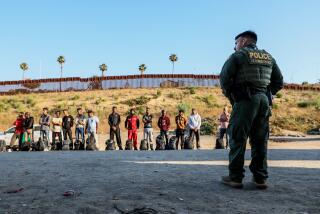Q&A: Family separations at the border: How did we get here?
Reporting from Washington — The Trump administration’s policy of separating children from their parents when families are apprehended crossing the border illegally caught many Americans by surprise.
Where did the policy come from, and what’s new about it? Here are answers to some often-asked questions.
When did government policy change?
On May 7, U.S. Atty. Gen. Jeff Sessions announced a new “zero tolerance” policy of border enforcement.
Henceforth, Sessions said, all immigrants who crossed the border illegally would be charged with a crime. Crossing without legal authorization is a misdemeanor. Unauthorized reentry after being deported is a felony.
In earlier years, individuals caught crossing illegally were often simply bused back over the border without charges, especially people from Mexico without criminal records or previous immigration violations. That option isn’t available for many border crossers coming from Central America, the origin point for the biggest share of illegal entrants in recent years.
During the current fiscal year, before the new policy, Border Patrol officers had detained about 288,000 people. Only about 30,000 were charged with a crime after crossing the border.
Under the old policy, people who crossed the border illegally, claimed they faced persecution in their home countries and asked for asylum were sometimes detained, but often were given a date for a hearing before an immigration judge and released until then. Under the new policy, those who cross illegally — not applying for asylum at a legal port of entry — will be charged with illegal entry.
Backlash builds against Trump’s policy splitting families at border »
Did officials say that zero tolerance would mean separating families?
Yes. Sessions spoke openly about that.
“If you are smuggling a child, then we will prosecute you, and that child will be separated from you as required by law,” Sessions said in Scottsdale, Ariz., as he announced the new policy.
“If you don’t like that, then don’t smuggle children over our border.”
If you are smuggling a child, then we will prosecute you, and that child will be separated from you.
— U.S. Atty. Gen. Jeff Sessions
Trump has said separating families is required by law. Is it?
No. There is no law that requires the government to separate children from their parents. That’s a policy choice the Trump administration has made.
White House officials do, correctly, say that current law and a series of court decisions limit how long they can hold minors in detention; adults in deportation proceedings can be held until their hearing date.
What’s the rationale for that policy choice?
Administration officials say they want to deter people from trying to immigrate illegally. They point to the dangers involved with illegal crossings, which often involve trafficking rings and are accompanied by violence. They hope that if parents believe they will be apprehended and their children taken from them, the numbers of people trying to cross illegally will go down.
“A big name of the game is deterrence,” White House Chief of Staff John F. Kelly told National Public Radio in an interview last month when asked about separating children from parents. “It could be a tough deterrent — would be a tough deterrent.”
“We don’t want to separate families, but we don’t want families to enter the border illegally,” Sessions said. “We urge them not to do so.”
Has that worked?
It’s really too soon to know. So far this year, the number of people apprehended crossing the border is up from the year before. The number is roughly similar to the previous several years. Illegal border crossings are far below the peak levels hit during the 1990s.
How does the process physically work?
Assume a family tries to cross somewhere along the Texas border, which is where the largest number of cases take place. About 40% of people apprehended in recent months have been in family groups — up from about 10% five years ago.
In many cases, people crossing the border illegally do not try to evade the Border Patrol. Instead, they surrender and claim asylum, saying they fear persecution in their home country in Central America. Although people have a legal right to claim asylum in the U.S., if they attempt to cross the border in a place other than a designated port of entry, they can be charged with illegal entry.
After being taken into custody, the zero tolerance policy requires that the migrants be charged. At that point, the adults will be jailed pending a trial. The children can’t be sent to an adult jail. They are considered unaccompanied minors and are transferred to the custody of the Office of Refugee Resettlement, part of the Department of Health and Human Services, which oversees a network of more than 100 shelters in 17 states.
The adults are typically held in jail for a few weeks until a court hearing. Most plead guilty and are sentenced to time served. At that point, they are transferred to immigration court where they can face deportation proceedings. If they have an asylum claim — as many do — they can raise that claim when they appear before an immigration judge, a process that often takes many months.
What used to be the process?
In the summer of 2014, when the number of families and unaccompanied minors apprehended at the border began to sharply increase, the Obama administration began putting hundreds of families into immigration detention facilities. Critics called the detention centers overcrowded, dirty and ill-equipped.
Courts ruled that the government could not hold families in custody for indefinite periods. Eventually, the administration began releasing most families after giving them a date to appear in immigration court. Critics, including Trump, deride that practice as “catch and release.” Government figures show that in most cases, those who were released have appeared in court as required, but many did not.
How many children does the government have in custody?
As of May 31, the government says 1,995 children have been separated from their parents.
They make up only one part of a larger group of children in the federal government’s custody. The Department of Health and Human Services says it currently has custody of 11,785 children. Many of those are teenagers who crossed the border unaccompanied by parents.
For its first nine years, the program served fewer than 8,000 children yearly, but the numbers started to jump dramatically in 2012. That increase came amid rising violence and continued poverty in El Salvador, Guatemala and Honduras, which led to a big increase in the number of people arriving at the U.S. border claiming asylum.
Will those children ultimately be reunited with their parents?
The government says that parents will have an opportunity to reunite with their children once the parents are no longer in jail. But the system for making that happen is uncertain. Advocates for the immigrants say that in some cases, parents have been deported without their children.
UPDATES:
10:30 a.m.: This article was updated with additional questions and answers.
6:25 p.m., June 18: The article was updated to note a difference in how the government handles Central Americans entering the U.S. illegally compared with the process for Mexicans.
3:20 p.m., June 18: The article was updated with a quote from White House Chief of Staff John F. Kelly.
The article was originally published at 12:35 p.m. on June 18.
More to Read
Get the L.A. Times Politics newsletter
Deeply reported insights into legislation, politics and policy from Sacramento, Washington and beyond. In your inbox three times per week.
You may occasionally receive promotional content from the Los Angeles Times.












